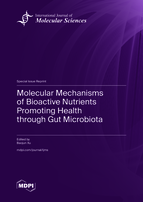Molecular Mechanisms of Bioactive Nutrients Promoting Health through Gut Microbiota
A special issue of International Journal of Molecular Sciences (ISSN 1422-0067). This special issue belongs to the section "Bioactives and Nutraceuticals".
Deadline for manuscript submissions: closed (30 June 2020) | Viewed by 60586
Special Issue Editor
Interests: phytochemicals; natural products; functional foods; human health
Special Issues, Collections and Topics in MDPI journals
Special Issue Information
Dear Colleagues,
It is becoming clear that human gut microbiota plays a critical role in human health. Depending on dietary intake and, consequently, nutrient availability within the gut, the human gut microbiota can produce either harmful metabolites that lead to human diseases or beneficial compounds that protect against host diseases. Abnormal gut microbiota can produce endotoxins which enhance chronic inflammation and metabolic disorders. Hence, a promising strategy to help manage colon health and host health is the modification of gut microbiota by bioactive food components to balance its composition. Bioactive components obtained from dietary sources can be designed and characterized to meet human nutritional and immunological needs as well as balance the gut microbiota. The goal of this Special Issue is to collect the latest research findings on the interrelationship among bioactive food components (such as phytochemicals and complex carbohydrates), gut microbiota, colon stem cells, and chronic metabolic diseases. The health benefits of small molecular phytochemicals and large biopolymer polysaccharides have been reported in different disciplines; however, it is not clear how gut microbiota metabolize these dietary phytochemicals and polymers, and how the resulting gut metabolites may further affect the gut microbial population, gut microbial metabolism, and colon stem cells.
Prof. Dr. Baojun Xu
Guest Editor
Manuscript Submission Information
Manuscripts should be submitted online at www.mdpi.com by registering and logging in to this website. Once you are registered, click here to go to the submission form. Manuscripts can be submitted until the deadline. All submissions that pass pre-check are peer-reviewed. Accepted papers will be published continuously in the journal (as soon as accepted) and will be listed together on the special issue website. Research articles, review articles as well as short communications are invited. For planned papers, a title and short abstract (about 100 words) can be sent to the Editorial Office for announcement on this website.
Submitted manuscripts should not have been published previously, nor be under consideration for publication elsewhere (except conference proceedings papers). All manuscripts are thoroughly refereed through a single-blind peer-review process. A guide for authors and other relevant information for submission of manuscripts is available on the Instructions for Authors page. International Journal of Molecular Sciences is an international peer-reviewed open access semimonthly journal published by MDPI.
Please visit the Instructions for Authors page before submitting a manuscript. There is an Article Processing Charge (APC) for publication in this open access journal. For details about the APC please see here. Submitted papers should be well formatted and use good English. Authors may use MDPI's English editing service prior to publication or during author revisions.
Keywords
- Phytochemicals
- Complex carbohydrates
- Bioactive nutrients
- Gut microbiota
- Prebiotics
- Probiotics
- Inflammation
- Molecular mechanisms
- Human health







